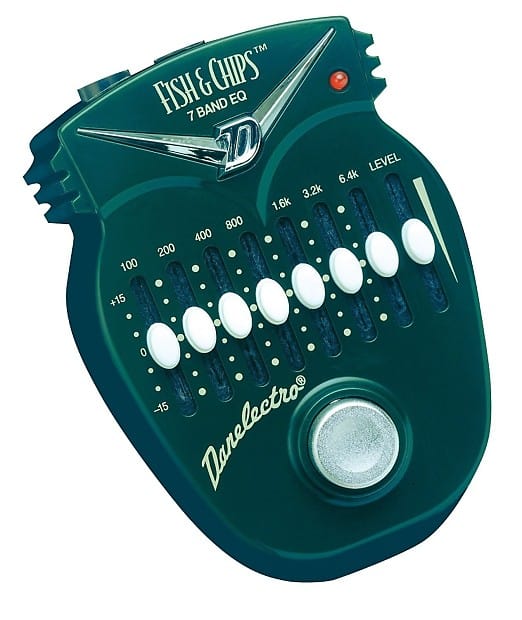I recently bought a Danelectro Fish and Chips EQ pedal in an attempt to tighten up my tone. I really like mine, so I’ve written this article to help convince you to buy one.
Over the course of this review, I’ll explain the purpose of an equalizer pedal – what it does and why you might want one. Then, I’ll explain why I think this pedal is an especially good choice.
This is an unbiased review. I bought my Danelectro Fish and Chips with my own money – I wasn’t loaned it or given it, and I haven’t been compensated to write this review. So, let’s begin!
Why get an EQ pedal at all?
Your guitar’s sound occupies a spectrum of high, low, and mid frequencies. Different frequencies within this audio spectrum will be made quieter or louder, depending on your equipment.
Electric guitars and pedals often have a “tone” knob, but it’s rarely obvious or predictable what they do – does turning the knob increase the highs, or the lows? Does it sweep the frequency range it’s affecting? Is it a notch at a narrow frequency position or does it shelve a wide range?
If you want to sculpt the frequencies of your sound in any kind of specific way, the tone knobs won’t be enough. To really shape your tone, you need something that allows precise control, and that’s where equalization (or EQ) gear comes in.
EQ gear for guitars usually comes in the form of a multi-band equalizer pedal (there is another kind of EQ pedal called a parametric EQ that we won’t discuss here). A typical EQ pedal has a few sliders or rotary knobs on top of the pedal, each affecting a specific band of frequencies. If your sound is too shrill, reduce the high frequencies. Too boomy? Reduce the lows. They’ll often also have an overall volume control, making them useful as boost pedals (eg to get louder for a solo).
EQ is great for helping sculpt your own sound, but equally important it helps you blend with other musicians. If you’re playing with a keyboardist, you’ll probably occupy similar frequency ranges, so your sounds might overwhelm each other. By using EQ, you can carve the right frequency range out for each band member.
Why go Danelectro?
- The more frequencies you can control, the more precisely you can shape your tone. Some pedals have five bands, some have seven, others have ten. The Danelectro Fish and Chips has seven bands: 100Hz, 200Hz, 400Hz, 80Hz, 1.6kHz, 3.2kHz, and 6.4kHz. This means the Fish and Chips gives you have a lot of flexibility to hone your sound.
- The build quality is high. The Fish and Chips is built from sturdy plastic. I’d prefer a metal enclosure, but plastic is an understandable compromise to keep the price low. Also, it’s practically noiseless – great for maintaing the integrity of your signal.
- The price is great. I bought mine brand-new for $20. Other comparable EQ pedals sell for at least twice that amount.
I like to place mine before my MXR Reverb pedal, since its Tone knob isn’t nearly precise enough for how big its sound is. By shelving some of the low frequencies, I’m able to keep my reverb sounds lush and not boomy.
In conclusion
The Danelectro Fish and Chips is a great choice if you want a lot of tone-shaping power at a low price. Check them out on Reverb.

